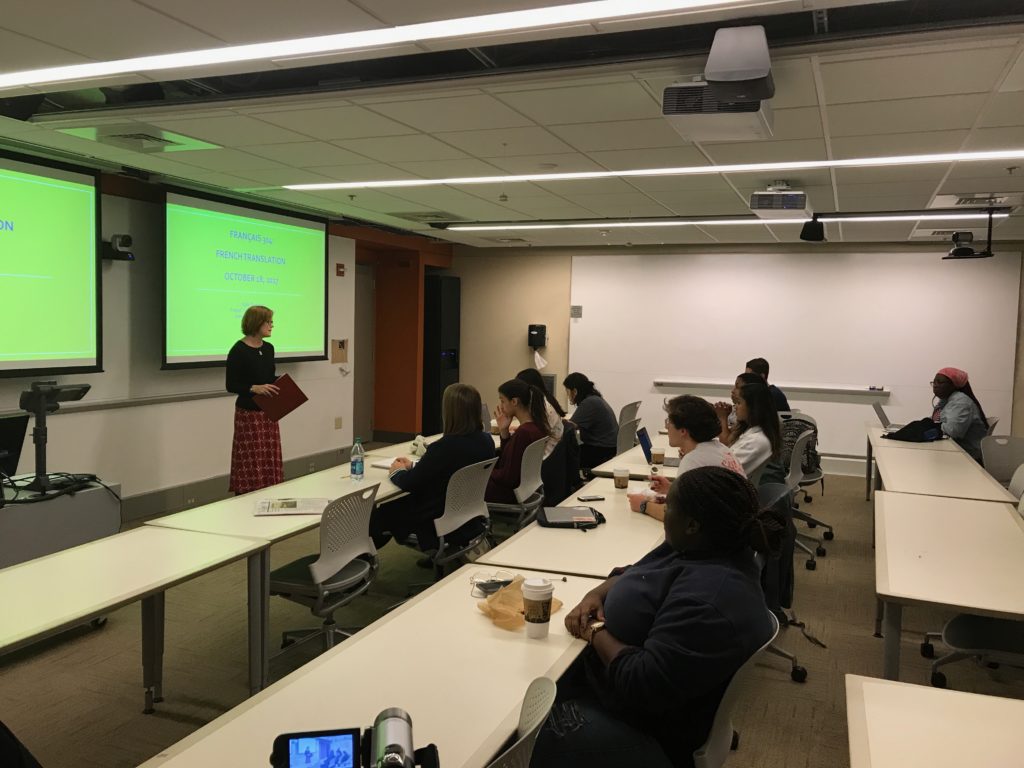Last month, I had the opportunity to speak to a French translation class at Duke University about the translation profession. I’ve previously blogged about starting a translation career, French fashion translation, and avoiding literalism (here and here). For this presentation, based on student interest, I focused on the fields of advertising and marketing, drawing examples from both the web and from print.
Translation, Transcreation, and Social Media
I started off with a brief overview of the translation job market and some background about my own career path. Then I shared examples from projects I’ve done (without identifying the companies involved, since translation work requires client confidentiality backed up by non-disclosure agreements). Sources for these examples included a manufacturer of baked goods, an energy company, a luxury goods company, and a high-end jewelry brand. I touched on various topics, including establishing tone of voice, making lexical and syntactical changes while maintaining the message, and incorporating client feedback. Language issues such as syntax and rhythm, verbal phrasing, and changes at the sentence level were also covered.
Transcreation, or the creative adaptation of advertising into another language, involves a lot of liberty to rewrite, especially when working with social media. For social media posts, the American subsidiaries of French companies are generally looking for a very different tone and style than their French counterparts, which I illustrated with examples. The interaction of text and image is also key, especially, but not only, on platforms such as Instagram and Twitter.

Website Localization and Adaptation
In the second part of my presentation, students had a chance to examine and analyze examples of translation by brands around the web. We examined websites together and saw how the layout, the products that are promoted, and the strategies can vary between the American websites and their French-language counterparts. The connection with the audience is sometimes established in different ways, and the “Frenchness” of the products involved may or may not be emphasized, depending on the industry and the marketing strategy.
It can be astonishing to see some companies spend so little effort on the translation of their websites. For instance, on the home page of the Barcelona-based brand Desigual, the categories of clothing are identified as “Man,” Woman,” and “Kids.”

The use of the singular “Man” and “Woman” is clearly a direct translation with no attention paid to English usage, and the invitation to “Check out Man, Kids, and Woman” has a strange ring to it in English.
Of course, the idea wasn’t to harp on poor translations. The larger point was to see that translation involves choices, and to have a concrete discussion about how those choices are made. Who is the audience? What message is being expressed? What emotions, responses, or associations are called up? Communication with the client is key to make sure that you understand the brand’s goals and strategies for the campaign in order to express them in the target language. Words resonate in different ways in every culture. For instance, the French words for “commitment” and “manifesto” have certain meaningful connections for French speakers that will not come across in the same way for an English-language audience. Similarly, if “frontière” is directly translated as “frontier,” as one student pointed out, it will evoke the history of Western expansion for an American public, which is not necessarily a desirable connotation. Translators must always study words in their natural environment — in the culture that they’re a part of.


